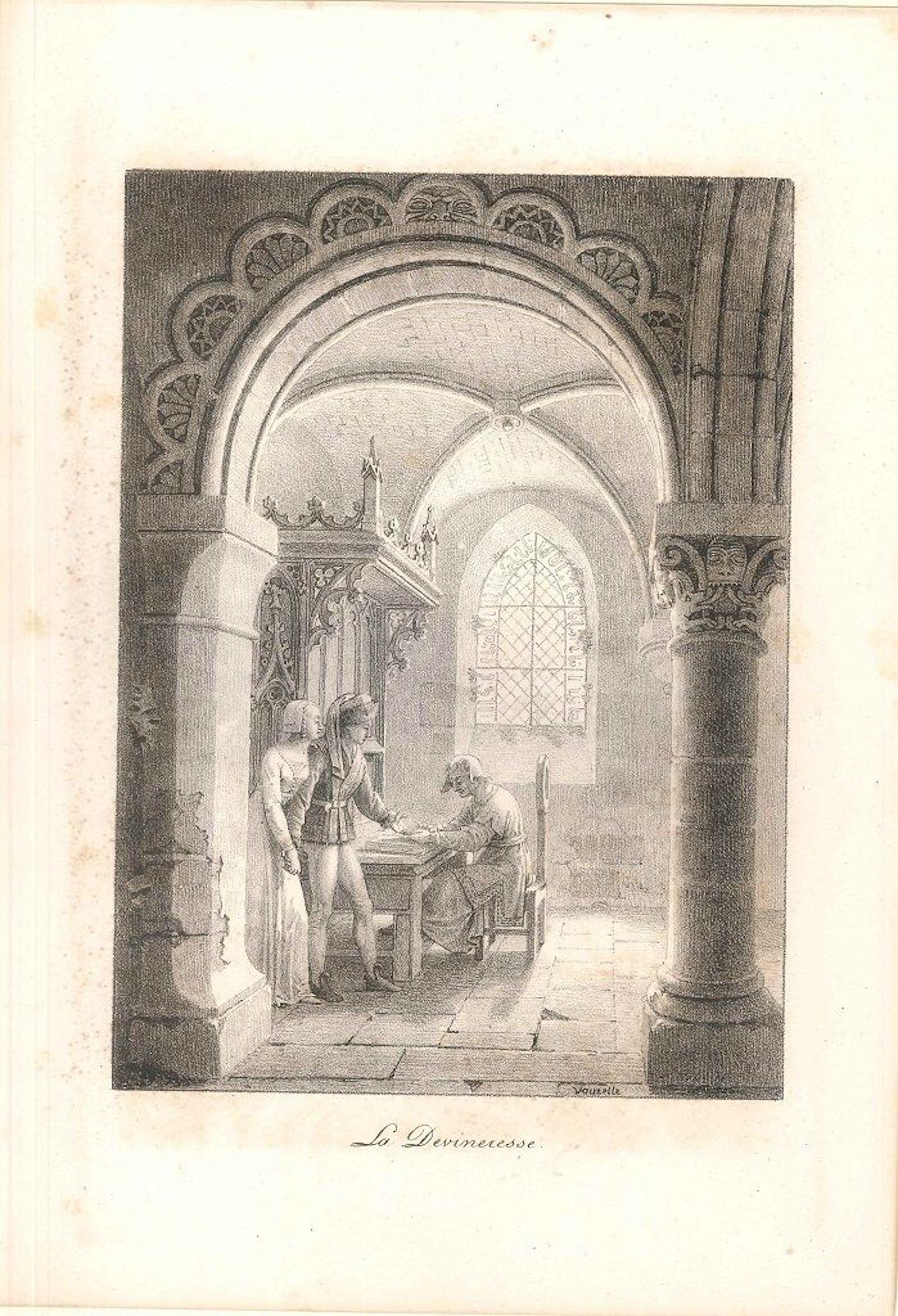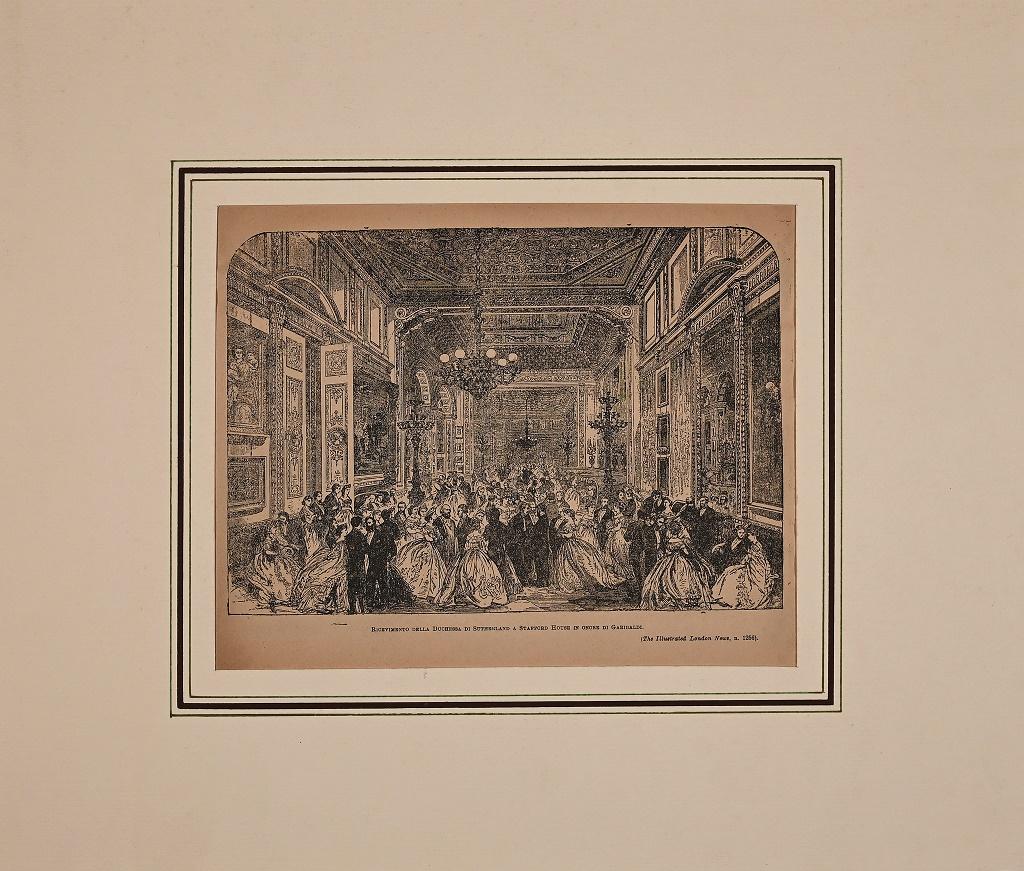Items Similar to Frontispiece from "Carceri d'Invenzione" - Etching by G. B. Piranesi - 1749/59
Want more images or videos?
Request additional images or videos from the seller
1 of 6
Giovan Battista PiranesiFrontispiece from "Carceri d'Invenzione" - Etching by G. B. Piranesi - 1749/591749/50
1749/50
About the Item
Carcere d'Invenzione is an original Modern Artwork realized by Giovan Battista Piranesi (Mogliano Veneto, 1720 - Rome, 1778).
Original Etching with Burin details on Laid paper. I state.
Inscripted in the center, in imitation of a carved epigraph: "INVENTIONS / CAPRIC OF PRISONS / ALL ACQVA FORTE / DATED IN LVCE / BY YOUNG PEOPLE / BOUCHARD IN / ROME MERCANTE / AL CORSO".
Print dimensions: mm 545 x 410; sheet dimensions: mm 635 x 494.
This beautiful specimen belongs to the first edition 1749/50.
In excellent conditions.
Reference:
Hind, Arthur Mayer, Giovanni Battista Piranesi : a critical study with a list of his published works and detailed catalogues of the prisons and the views of Rome, London, Cotswold Gallery, 1922, 1. (ed. consultata London, Holland Press, 1967), p. 24, n. 1;
Focillon Henri, Giovanni Battista Piranesi, ediz. italiana a cura di Maurizio Calvesi e Augusta Monferini, Bologna, Alfa, 1967, p. 285, n. 24;
Robison Andrew, Piranesi. Early architectural fantasies. A Catalogue Raisonné of the Etchings, Washington, National Gallery of Art, 1986, n. 29/II;
Wilton-Ely John, Giovanni Battista Piranesi. The complete etchings, San Francisco, AlanWofsy, 1994, n. 26;
Ficacci Luigi, Piranesi. The complete etchings, Koln, Taschen, 2000 (ed. 2001), pp. 128-153.
The scene is an example of the entire cycle, one of the most cryptic and technically complex due to the creative genius of the Venetian engraver. The title is placed on a huge gravestone, placed close to a wall; walkways leading in different directions and a wide staircase are described on the right while a chained figure, characterized by a dramatically tense expression, is outlined above the title and dominates the entire composition. The representation closes on the left with a part of the wall arch that seems to open the viewer's gaze on a world of anguish and fear.
Many states have been identified - nine those reported by Robison - even after the artist's death, when the branches were purchased by the publisher Firmin-Didot, which in 1835-1839 succeeded with a fifth edition. Focillon carefully details the question of the dating of the first edition and the different theses expressed by scholars starting as early as the end of the 18th century; many agree in distinguishing the engraving of the plates, to be traced back to about 1745, from their publication, which took place around 1750, while the final enlarged edition of two tables would be placed between 1760 and 1761. Several drawings can be traced back to the plates of the series. .
Giovanni Battista Piranesi, also known as Giambattista (Venice, 1720 - Rome, 1778), was an Italian engraver, architect and theorist of architecture. His engraved tables, marked by dramatic intonation and graphics, appear to be marked by an idea of Roman dignity and magnificence, expressed through the grandeur and isolation of the architectural elements, in order to arrive at a sublime feeling of grandeur of the ancient past, although marked by inexorable abandonment. The eclecticism of his works and the versatility of his creative inspiration make Piranesi an artist difficult to insert within a schematic dictated by a subdivision into styles or artistic currents. A personality with a double cultural matrix, Venetian and Roman, Piranesi has a very complex artistic physiognomy, which can be divided into three fundamental components. In fact, Piranesi's art has deep roots in the Rococo tradition, of which he is one of the last heirs. This adherence to Rococo can be found not only in the quality of the design, unmade and evocative, but above all in the very nature of his works, which are configured as capricious inventions (as we read in the title page of the Carceri): with this exquisitely Rococo name, in fact , Piranesi wanted to indicate the imaginative and unusual character of his creations.
- Creator:Giovan Battista Piranesi (1720 - 1778)
- Creation Year:1749/50
- Dimensions:Height: 25.2 in (64 cm)Width: 19.69 in (50 cm)Depth: 0.04 in (1 mm)
- Medium:
- Movement & Style:
- Period:
- Framing:Framing Options Available
- Condition:Insurance may be requested by customers as additional service, contact us for more information.
- Gallery Location:Roma, IT
- Reference Number:
About the Seller
4.9
Platinum Seller
These expertly vetted sellers are 1stDibs' most experienced sellers and are rated highest by our customers.
1stDibs seller since 2017
6,794 sales on 1stDibs
Typical response time: 3 hours
- ShippingRetrieving quote...Ships From: Rome, Italy
- Return PolicyA return for this item may be initiated within 14 days of delivery.
More From This SellerView All
- Le Peseur d'Or - Original Etching by Léopold Flameng - 1873By Léopold FlamengLocated in Roma, ITLe Peseur d'Or (The Money Exchanger) is a wonderful black and white etching on wire rod cream-colored paper, realized by Léopold Flameng, an after by the Flemish artist Gabriel Metsu...Category
1870s Modern Figurative Prints
MaterialsEtching
- La Devineresse - Original Etching by J-L Vauzelle - End of 18th CenturyLocated in Roma, ITLa Devineresse is an original artwork realized by Jean-Lubin Vauzelle in the second half of the XVIII century. Original etching on paper. Passepartout included (39 x 28.5 cm). Sign...Category
Late 18th Century Modern Figurative Prints
MaterialsEtching
- Chez François Bouvin - Original Etching After François Bouvin by Charles CoutryBy Charles CoutryLocated in Roma, ITChez François Bouvin is a wonderful etching realized in 1891 by Charles Courtry, after François Bouvin. This Modern artwork representing a scene of ordinary life, is a beutiful arti...Category
1890s Modern Interior Prints
MaterialsEtching
- Reception of the Duchess of Sutherland - Original Zincography - 1864Located in Roma, ITReception of the Duchess of Sutherland is an original zincography realized by an artist of the 19th century (1864). The artwork represent the re...Category
1860s Modern Interior Prints
MaterialsEtching, Paper
- The Party - Original Etching by Charles Courtry - Late 19th CenturyBy Charles CourtryLocated in Roma, ITSelf Portrait is an original artwork realized by Charles Courtry (1846-1897) in the Late 19th Century. Etching print. Signed on plate. Good conditions. The artwork is depicted th...Category
19th Century Modern Interior Prints
MaterialsEtching
- Ancient Roman Painting - Etching by N. Orcity, N. Vanni - 18th CenturyLocated in Roma, ITAncient Roman painting- Offering Scene from the series "Antiquities of Herculaneum", is an original etching on paper realized by Nic Orcity an...Category
18th Century Modern Figurative Prints
MaterialsEtching
You May Also Like
- PoliticsBy Edmund BlampiedLocated in Storrs, CTPolitics (Tonnere de Brest). 1926. Drypoint. Appleby 108. 7 x 9 (sheet 10 1/2 x 15 1/2). A rich impression printed on cream wove paper with full margins. Illustrated: Salaman, Modern...Category
Early 20th Century Modern Figurative Prints
MaterialsDrypoint, Etching
- ChristmasBy Robin TannerLocated in Storrs, CTChristmas. 1970. Etching. Garton catalog 9 state ii. 15 1/2 x 10 3/4 (sheet 20 1/8 x 17 1/4). Edition of 50. From the Penn Print Room edition published by McDonald and Nicholson in 1...Category
1920s Modern Interior Prints
MaterialsEtching
- The LetterBy Edmund BlampiedLocated in Storrs, CTThe Letter. 1921. Drypoint. Appleby 107. 7 x 9 3/8 (sheet 10 1/2 x 15 7/16). Edition 100. Illustrated: Fine Prints of the Year, 1925; Salaman, Modern Masters of Etching: Edmund Blamp...Category
Early 20th Century Modern Figurative Prints
MaterialsDrypoint, Etching
- La Gaité Montparnasse.By Walter SickertLocated in Storrs, CTLa Gaité Montparnasse.. c. 1919. Etching. Bromberg catalog 186 state iii. Image: 3/4 x 4 1/4 (sheet 9 3/16 x6 3/4). No stated lifetime edition. 19 posthumous impressions were printed for the Sickert Trust (1945-47). This is proof #7. Illustrated English Prints for the Collector, p. 163. A rich impression printed on cream laid paper. An extremely scarce etching in Sickert's oeuvre. The image is of a music-hall interior. Signed in the plate. Housed in an elegant French mat and a stunning 14 1/2 x 11 1/2 x 2-inch silver wood frame. Walter Richard Sickert...Category
Early 20th Century Modern Interior Prints
MaterialsEtching
- France at her FurnacesBy James McBeyLocated in Storrs, CT1917. Etching. Hardie 175. 8 x 15 (sheet 10 1/8 x 16 15/16). Edition 76. Slight mat line; otherwise excellent condition. A rich impression printed on antique laid paper with full m...Category
1910s Modern Interior Prints
MaterialsDrypoint, Etching
- SoupBy Edmund BlampiedLocated in Storrs, CTSoup. 1920. Drypoint. Appleby 65. 9 x 8 1/8 (sheet 15 x 11 9/16). Edition 100. Illlustrated: Print Collector's Quarterly 13 (1926): 85. Signed in pencil. Edmund Blampied was a painter, etcher, lithographer and sculptor. Born in 1886 to a family of three boys in St. Martin, Jersey, Blampied became interested in drawing at an early age. After visiting the studio of John Helier Lander in 1899, Blampied decided to make a career as an artist. In 1903 he went to London to attend Lambeth Art School, where he studied etching under Walter Seymour. In 1905, he joined the Daily Chronicle as an artist. In that year he was awarded a scholarship to Bolt Court Scool of Photo-engraving and Lithography. In 1912 he left the Chronicle and established his own studio. He earned a living by illustrating novels and short stories. In 1913, he had his first exhibition at the Leicester Gallery in London. The following year he married Marianne Van Abbé. During the 1920's, he became a member of the Royal Society of Painter-Etchers and Engravers. During the 1920s Blampied became a member of the Royal Society of Painters-Etchers and Engravers and exhibited in London to critical acclaim. He produced a folio of comic drawings in the 1930s which was published in New York in 1934 and another that was published in London in 1936. The Keeper of Prints and Drawings at the British Museum published a mongraph on his work. His London exhibitions were highly successful. In 1938, he moved to Bulwarks, St.Aubin in Jersey, but at the onset of the Occupation, had to relocate to Route Orange, St. Brelade. remained there throughout World War II during the German Occupation, despite the fact that his wife was Jewish. During the Occupation he designed bank...Category
1920s Modern Figurative Prints
MaterialsDrypoint, Etching
Recently Viewed
View AllMore Ways To Browse
Antique 50
Traces D
Dutch 18th Century Table
B And N Wall
Midcentury Modern Architectural Scene
18th Century Italian Rococo Table
Rococo Venice
Antique Cycling Prints
Gaze E
Luigi B
Wilton Antique
Cotswold Table
18th Century Rococo Center Tables
After Giovanni Battista Piranesi
Venetian Fantasy
Venetian End Tables
Augustas John
Cotswold Wall Art



